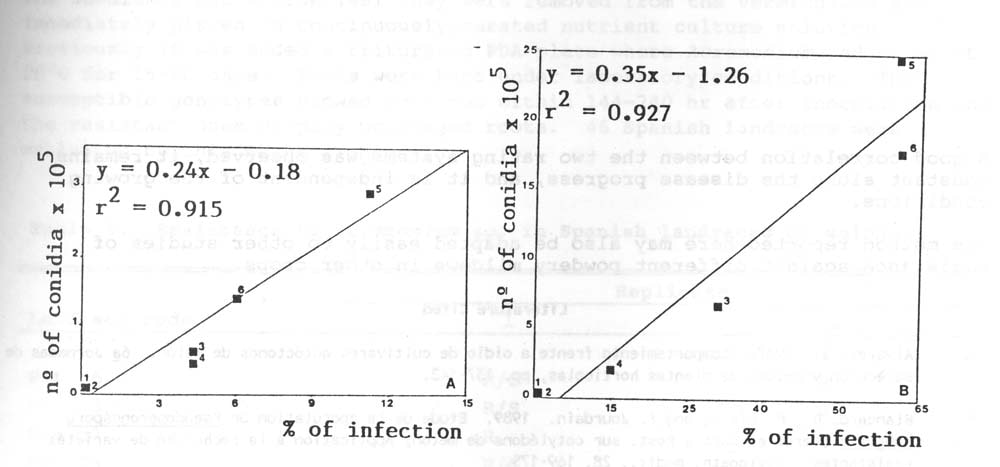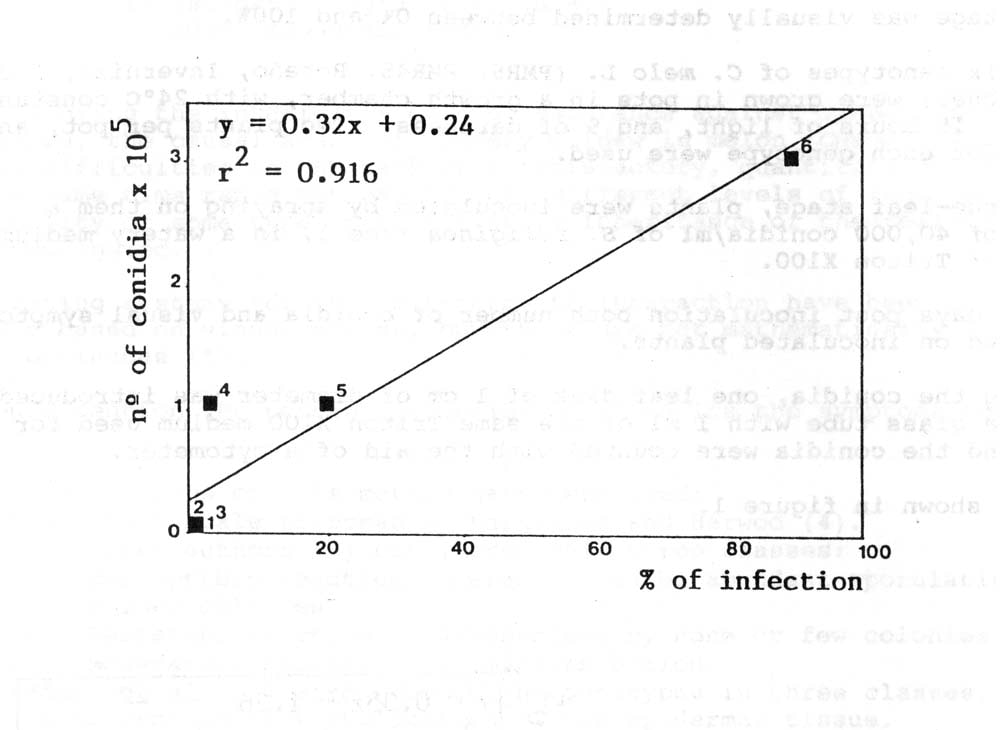Cucurbit Genetics Cooperative Report 14:46-48 (article 16) 1991
Elena Floris and Jose Ma Alvarez
Servicio de Investigacion Agraria – D.G.A. Apartado 727, 50080, Zaragoza, Spain
When studying the inheritance of the resistance against Sphaerotheca fuliginea, the causal agent of powdery milder in melon (Cucumis melo L.), one of the difficulties is the lack of a satisfactory, quantitative, objective and at the same time rapid method, to test different levels of resistance when the possibility of some type of quantitative inheritance of the resistance is to be investigated.
Many rating systems for the host-parasite interaction have been proposed, usually based on visual scales, but those, which are not mathematically linear nor even continuous (5).
We could mention the percentage scale, which notice the symptoms between 0% to 100%.
Several variations of this method have been used:
- The 1 to 5 scale proposed by Markarian and Harwood (4).
- Some other authors (5) considered only three classes:
- Susceptible reaction, characterized by abundant sporulating powdery mildew colonies
- Resistant reaction, characterized by none or few colonies.
- Moderately resistant, by mild infection.
- Temmen et al. (6) also grouped the genotypes in three classes, based in the percentage of vacuolization of the epidermal tissue.
These modifications of the percentage scale, simplify the characterization of the cultivars, but classified them a priori into discrete classes which is not suitable for quantitative analysis.
Possibly a good method is the evaluation of the ADPC (area under the disease progress curve) (3), but it needs to spend a lot of time monitoring the infection rates.
A preliminary study was carried out in 1986, with some local cultivars of melon (Table 1), finding intermediate and different levels of resistance/susceptibility to powdery mildew (1).
Because of these results, the necessity of finding a good rapid and easy method for testing those intermediate degrees of resistance appeared.
Table 1. Mean values of ADPC for different muskmelon cultivars grown in the field.
Cultivar |
ADPC |
| PMR 45 | 0.0000 |
| PMR 5 | 0.0000 |
| Negro | 0.0000 |
| Roteno | 0.0000 |
| Moscatel Grande | 0.0005 |
| Amarillo | 0.0005 |
| Agostizo | 0.1033 |
| Invernizo | 0.0555 |
| Doublon | 0.2225 |
| Piel de Sapo | 0.2016 |
Blancard et al. (2) working with Pseudoperonospora cubensis proposed a method which is related with the amount of pathogen present in host tissues. Based on this, we tried to assess if the number of S. fuliginea conidia is related with the degree of resistance measured as the percentage of diseased tissue.
This percentage was visually determined between 0% and 100%.
Plants of six genotypes of C. melo L. (PMR 5, PMR 45, Roteno, Invernizo, Piel de Sapo and Rochet) were grown in pots in a growth chamber, with 24°C constant temperature, 15 hours of light, and 9 of darkness. Two plants per pot, and ten plants for each genotype were used.
At second true-leaf stage, plants were inoculated by spraying on them a suspension of 40,000 conidia/ml of S. fuliginea race 1, in a watery medium with 1 ppm of Triton X100.
Six and ten days post inoculation both number of conidia and visual symptoms were recorded on inoculated plants.
For counting the conidia, one leaf disk of 1 cm of diameter was introduced and shook into a glass tube with 1 ml of the same Triton X100 medium used for spraying, and the conidia were counted with the aid of a cytometer.
Results are shown in Figure 1.

Another assay carried out in the field, monitoring the symptoms in the same way, 35 days post infection results are shown in Figure 2.
 A good correlation between the two rating systems was observed, it remains constant along the disease progress, and it is independent of the growing conditions.
A good correlation between the two rating systems was observed, it remains constant along the disease progress, and it is independent of the growing conditions.
The method reported here may also be adapted easily to other studies of resistance against different powdery mildews in other crops.
Literature Cited
- Alvarez, J. 1987. Comportamiento frente a oidio de cultivares autoctonos de melon. 6a Jornadas de selection y mejora de plantas horticolas, pp. 137-142.
- Blancard, D., M. Pitrat and F. Jourdain. 1989. Etude de la sporulation de Pseudoperonospora cubensis (Berk. et Curt.) Rost. sur cotyledons de melon; application a las recherche de varietes resistantes. Phytopath. Medit. 28: 169-175.
- Fry, W. E. 1978. Quantification of general resistance of potato cultivars aqnd fungicidal effects for integrated control of potato late blight. Phytoipathology 68:1650-1655.
- Markarian, D. and R. Harwood. 1967. The inheritance of powery mildew resistance in C. melo: identification of greenhouse conditions necessary for phiphytosis and correlation of apparent genetic resistance to field conditions. Quart. Bull. Mich. State Univ. Agr. Exp. Sta. 49:404-411.
- Spencer, D.M. 1978. The powdery mildews. Ed. Academic Press (London Ltd.) pp 359-379.
- Temmen, K.H., W. Gruppe, and E. Schlosser. 1980. Basis for horizontal resistance of cucumber against Sphaerotheca fulginea. Proceedings of the Eucarpia Meeting: Breeding of cucumber and melons, 19-22, August 1980, Wageningen, pp. 16-22.